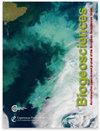Deciphering the origin of dubiofossils from the Pennsylvanian of the Paraná Basin, Brazil
IF 3.9
2区 地球科学
Q1 ECOLOGY
引用次数: 0
Abstract
Abstract. Minerals are the fundamental record of abiotic processes over time, while biominerals are one of the most common records of life due to their easy preservation and abundance. However, distinguishing between biominerals and abiotic minerals is challenging due to the superimposition and repetition of geologic processes and the interference of ubiquitous and diverse life on Earth's surface and crust. Mineral dubiofossils, being potential outcomes of both abiotic and biotic environments, emerge as valuable entities that can contribute significantly to the understanding of this issue, facilitating the testing and refinement of biogenicity criteria. The aim of this contribution is to decipher the origin and history of branched mineralized structures that were previously considered mineral dubiofossils from the Pennsylvanian of the Paraná Basin, Brazil. While this material has different forms and refers to biological aspects, it is challenging to associate it with any known fossil group due to the overlapping geological processes occurring in a transitional deposit of Rio do Sul Formation (Itararé Group of the Paraná Basin), particularly in close proximity to a sill from the Serra Geral Group (Lower Cretaceous), which has undergone thermal effects. Given the absence of attributes essential for supporting the initial hypotheses proposing the material as a potential set of sponge spicules or a result of contact metamorphism in Pennsylvanian turbidites, the objects are now investigated as mineral dubiofossils. To address this challenge, we have developed a descriptive protocol for dubiofossils, building upon prior research in the field. This protocol evaluates the following aspects: (1) morphology, texture, and structure; (2) relationship with the matrix; (3) composition; and (4) context. This is done by assessing indigeneity and syngenicity and comparing the specimens with abiotic and biotic products. Applying this protocol to our samples revealed a wide range of morphologies with internal organization, predominantly composed of calcite with impurities such as iron, magnesium, aluminum, and oxygen. The inferred indigeneity suggests the presence of these minerals concurrently with or prior to the intrusion of the sill. Extensive comparisons were made between the studied samples and a broad spectrum of abiotic minerals, as well as controlled, induced, and influenced biominerals from similar contexts. These comparative analyses encompassed sponge spicules; sea urchin and algae skeletons; minerals induced or influenced by fungi, bacteria, and microbial mats; and inorganic pre- and synsedimentary–eodiagenetic minerals like evaporites, springs, and other precipitates, and mesodiagenetic–metamorphic crystals. Despite this comprehensive analysis, no hypothesis emerged as significantly more likely than others. The comparative analysis did allow us to exclude the possibility of the samples being controlled biominerals due to their patternless diversity of morphologies, as well as purely thermometamorphic in origin due to their branched elongated forms. The occurrence of these structures suggests a complex history: a syn-depositional or eodiagenetic origin of some carbonate or sulfate (gypsum, ikaite, dolomite, calcite, aragonite, siderite), potentially associated with the presence of microbial mats, which may have served as templates for mineralization and mediated mineral growth. Mesodiagenesis could have further modified the occurrence through processes such as mineral stabilization, agglutination, aging, and growth. However, the primary agent responsible for the formation of the dubiofossil was the Cretaceous intrusion, which dissolved and replaced the initial minerals, resulting in the precipitation of calcite. Throughout these steps, a combination of physical–chemical and biological reactions, influenced by intrinsic matrix characteristics, organic matter content, and distance from the intrusive body, may have contributed to the heightened morphological complexity observed, thus corroborating the origin of the material becomes even more challenging. Consequently, both the hypotheses pertaining to the formation of biotic and abiotic sulfates and carbonates remain plausible explanations, hence sustaining the classification of the material as a dubiofossil. This material illustrates how dubiofossils can be a result of a complex history and overlapping geological processes. It also highlights the difficulty in differentiating biominerals from abiotic minerals due to the scarcity of biogenicity arguments.破译来自巴西帕拉纳盆地宾夕法尼亚地区的可疑生物化石的来源
摘要矿物是随时间推移的非生物过程的基本记录,而生物矿物是最常见的生命记录之一,因为它们易于保存和丰富。然而,由于地质过程的叠加和重复以及地球表面和地壳上无处不在的多种生命的干扰,区分生物矿物和非生物矿物是具有挑战性的。矿物可疑生物化石作为非生物和生物环境的潜在结果,成为有价值的实体,可以为理解这一问题做出重大贡献,促进生物性标准的测试和完善。这项贡献的目的是破译分叉矿化结构的起源和历史,这些结构以前被认为是来自巴西帕拉纳盆地宾夕法尼亚的矿物可疑生物化石。虽然这种材料具有不同的形式,并涉及到生物学方面,但由于在Rio do Sul组(paran盆地的itarar组)的过渡矿床中发生重叠的地质过程,特别是在Serra Geral组(下白垩纪)的一个岩床附近,它经历了热效应,因此将其与任何已知的化石群联系起来是具有挑战性的。由于缺乏必要的属性来支持最初的假设,即该材料可能是一组海绵针状体或宾夕法尼亚浊积岩中接触变质作用的结果,因此现在将这些物体作为矿物可疑生物化石进行研究。为了应对这一挑战,我们在该领域先前的研究基础上,制定了一项关于可疑生物化石的描述性协议。该方案评估以下方面:(1)形态、质地和结构;(2)与矩阵的关系;(3)组成;(4)语境。这是通过评估原生和同源性,并将标本与非生物和生物产品进行比较来完成的。将该方案应用于我们的样品显示了广泛的内部组织形态,主要由方解石和杂质组成,如铁,镁,铝和氧。推断出的原生性表明,这些矿物与岩台侵入同时存在或先于岩台侵入。在研究样品和广泛的非生物矿物以及来自类似环境的受控、诱导和受影响的生物矿物之间进行了广泛的比较。这些比较分析包括海绵针状体;海胆和海藻骨架;由真菌、细菌和微生物席引起或影响的矿物质;无机的沉积前成岩和同沉积成岩矿物,如蒸发岩、泉水和其他沉淀物,以及中成岩变质晶体。尽管进行了全面的分析,但没有一种假设的可能性明显高于其他假设。比较分析确实使我们排除了样品被控制生物矿物的可能性,因为它们的形态无模式多样性,以及纯粹的热变质起源,因为它们的分支拉长形式。这些构造的出现表明了一个复杂的历史:一些碳酸盐或硫酸盐(石膏、钙钛石、白云石、方解石、文石、菱铁矿)的同沉积或成岩起源,可能与微生物席的存在有关,这些微生物席可能作为成矿和介导矿物生长的模板。中成岩作用可能通过矿物稳定、凝集、老化和生长等过程进一步改变其发生。然而,白垩纪的入侵溶解并取代了最初的矿物,导致方解石的沉淀,是造成双生物化石形成的主要原因。在这些步骤中,受固有基质特征、有机物含量和与侵入体的距离的影响,物理化学和生物反应的结合可能导致观察到的形态复杂性增加,因此证实材料的来源变得更加具有挑战性。因此,关于生物和非生物硫酸盐和碳酸盐形成的假设仍然是合理的解释,因此维持了该材料的分类为可疑化石。这些材料说明了可疑的生物化石如何成为复杂的历史和重叠的地质过程的结果。它还强调了由于生物源性论点的稀缺性,区分生物矿物和非生物矿物的困难。
本文章由计算机程序翻译,如有差异,请以英文原文为准。
求助全文
约1分钟内获得全文
求助全文
来源期刊

Biogeosciences
环境科学-地球科学综合
CiteScore
8.60
自引率
8.20%
发文量
258
审稿时长
4.2 months
期刊介绍:
Biogeosciences (BG) is an international scientific journal dedicated to the publication and discussion of research articles, short communications and review papers on all aspects of the interactions between the biological, chemical and physical processes in terrestrial or extraterrestrial life with the geosphere, hydrosphere and atmosphere. The objective of the journal is to cut across the boundaries of established sciences and achieve an interdisciplinary view of these interactions. Experimental, conceptual and modelling approaches are welcome.
 求助内容:
求助内容: 应助结果提醒方式:
应助结果提醒方式:


